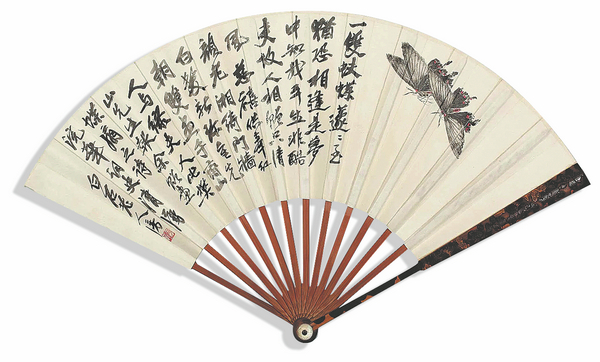

"This was especially true when an audience was given by an emperor to his subjects. It is believed that in ancient Japan, court officials may have initially done so with a bamboo slip, with its official-facing side written with a summary of what the man had planned to say to the emperor," Yang says.
"Sometimes one needs a few reminders to appear totally calm and prepared in front of the big boss.
"And when you are holding more than one such slips and spreading them out in front of your eyes, you get a fan."
In 1978, a multilayered, red-lacquered makeup box was discovered in Changzhou city, eastern China's Jiangsu province, in a tomb dating to the Southern Song period (1127-1279).
In the design on its cover, highlighted in gold, two well-dressed young ladies appear in the middle of a manicured garden, waited on by an attendant. While the one on the left is holding a palm leaf of a fan, the one on the right holds a painted folding fan whose bamboo ribs are clearly discernible.
"This is the earliest archaeological proof so far found for a folding fan, although it's essentially a visual depiction. As to real objects, the earliest ones we have now date back to the early Ming Dynasty (1368-1644)," says Yang, pointing to a fan within the collection of the Palace Museum, which is believed to have been painted by Emperor Xuanzong (1399-1435), the fifth emperor of Ming.
With a maximum width of 151 centimeters, this particular one is a lot bigger than an average folding fan, and was probably meant for the wall. On one side of it, the emperor painted a loosely robed scholar-recluse reclining under a pine tree, a hand-scroll of writing lying on the ground nearby.
"The image was embedded in China's literati culture, which celebrated a life lived away from all the chaos and trappings of the world," says Yang.
"Throughout China's Ming and Qing (1644-1911) dynasties, painting, calligraphy and poetry were dubbed 'the three perfections' and were required of a cultured man. A folding fan was carried around as a showcase, if not of a man's own literary and artistic talent, then at least his taste in such matters."
That might explain why, within those six centuries, many who had established themselves in the overlapping worlds of art and poetry had created fan art.
"One challenge lies with compositional arrangement: You have to be mindful of the shape of a fan and the limited amount of space you are given," says Ma Xiangjun, a Suzhou-based calligrapher who has inscribed more than a few folding fans made by Xu Jiadong, a much-celebrated local fan-maker.
"Meanwhile, a fan is opened, bit by bit. And whoever is creating fan art needs to be able to visually guide his viewers through that experience."
"A window with a view" — that's Yang's metaphor for the framed picture contained within the fan's surface. "What is that view made up of? Sometimes it could just be a bough laden with flowers; other times, it comprises a serene landscape of misty mountains and meandering rivers," she says.
One contemporary Chinese painter who has worked for decades with ink and brush and has often painted folding fans is Li Yunlei.